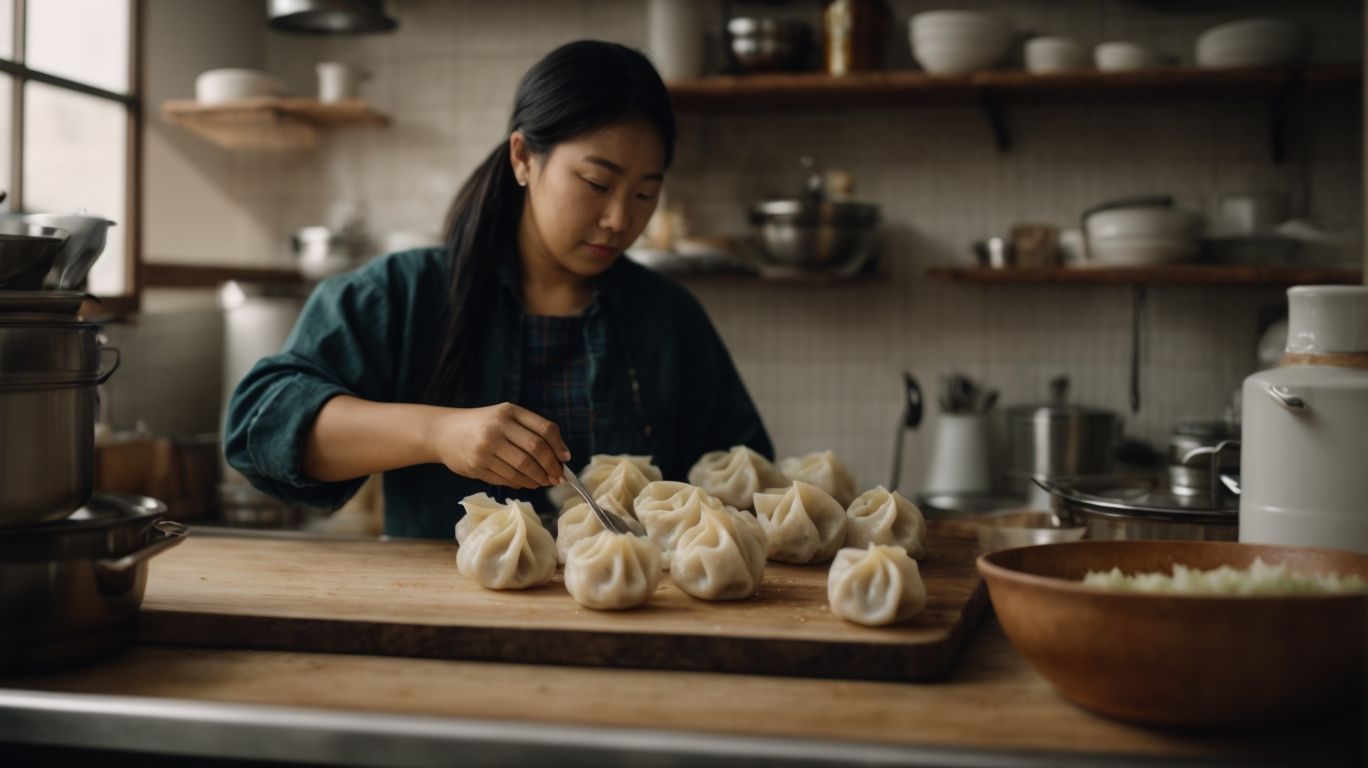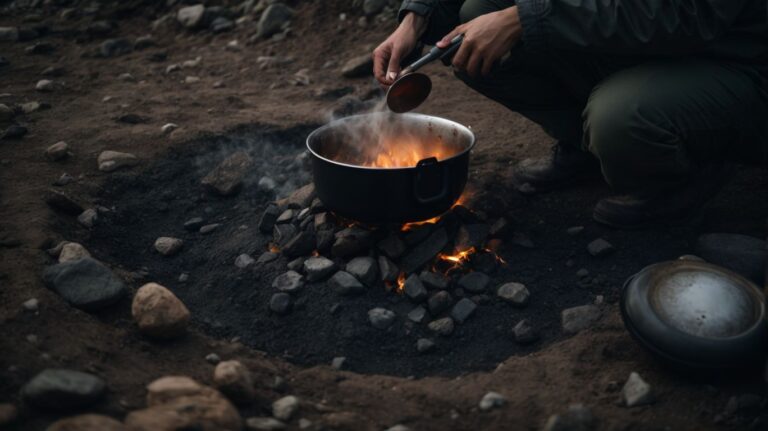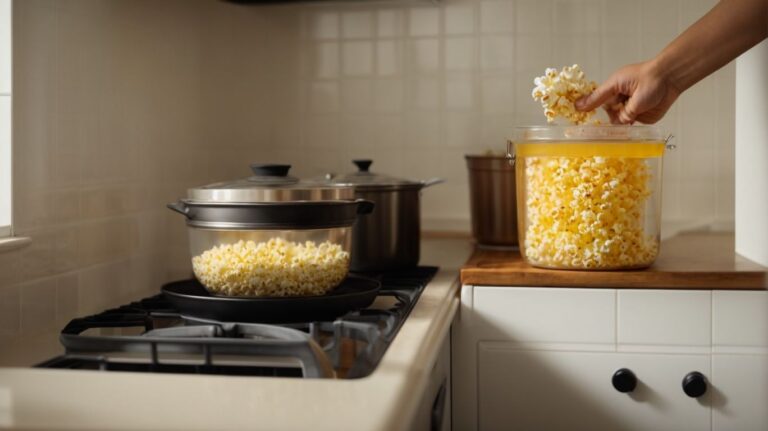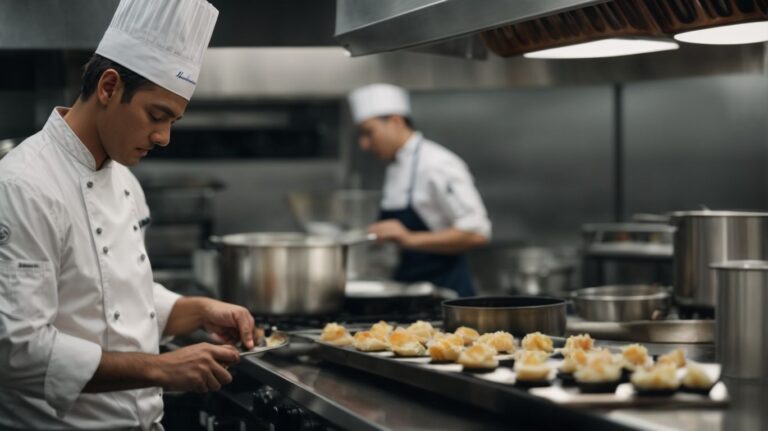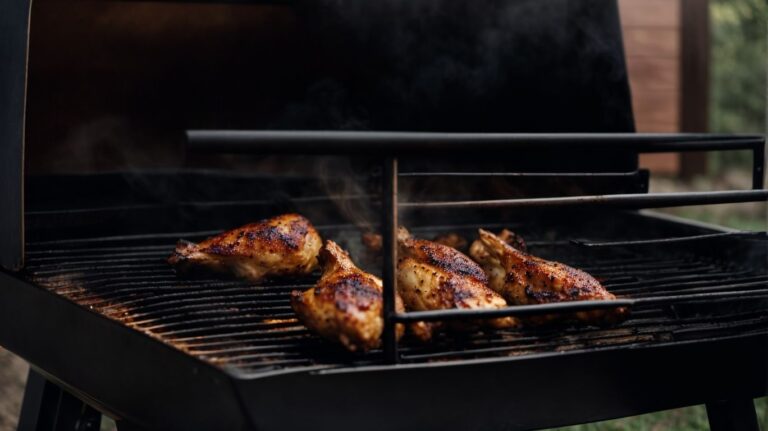How to Cook Dumplings for Soup?
Are you a fan of comforting and hearty soups? Have you ever wondered what exactly are dumplings and how they can elevate your soup game?
Explore the world of dumplings, from the different types like Chinese, Polish, Italian, and American, to tips on making the perfect dumplings for soup.
Delve into variations like vegetarian, gluten-free, and spicy dumplings. Grab a bowl of soup and get ready to discover the delicious world of dumplings!
Key Takeaways:
What Are Dumplings?
Dumplings are versatile, dough-based food items that can be filled with a variety of ingredients and cooked through steaming, boiling, or baking.
These beloved culinary creations are found in cuisines across the globe, each with its own unique twist. From Chinese wontons to Italian ravioli, dumplings take on various forms and flavors, reflecting the diverse cultures that embrace them. In Asian cuisine, you have delicate soup dumplings and potstickers, while Eastern European cuisine offers hearty pierogies and pelmeni. Their cultural significance extends beyond mere sustenance, often symbolizing luck, prosperity, and unity during festive gatherings.
What Are the Different Types of Dumplings?
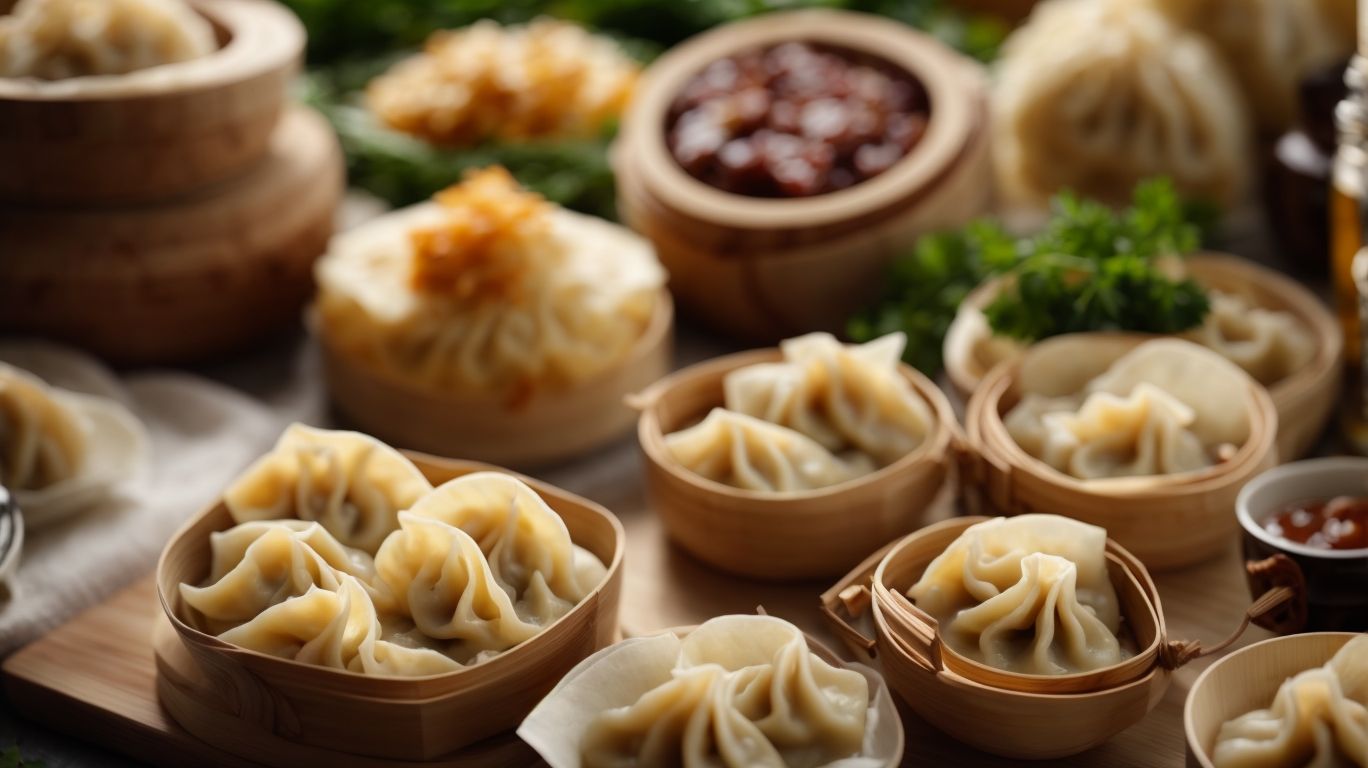
Credits: Poormet.Com – Roy Wright
Dumplings come in various forms across different cuisines, with Chinese, Polish, Italian, and American styles offering unique flavors and textures.
Chinese dumplings, also known as Jiaozi, are commonly filled with pork, shrimp, or vegetables and encased in a thin dough wrapper. These dumplings are often served with a dipping sauce made of soy sauce, vinegar, and chili oil, adding a perfect balance of savory and tangy flavors.
On the other hand, Polish pierogi are a staple in Eastern European cuisine, typically filled with a mixture of potatoes, cheese, meat, or fruit. They are then boiled and often pan-fried to achieve a crispy exterior, enhancing the overall texture of the dumpling.
Italian ravioli, a popular pasta dumpling, is filled with various ingredients such as ricotta cheese, spinach, and meat, enveloped in a tender pasta dough and simmered in flavorful sauces like marinara or alfredo.
American dumplings, like chicken and dumplings, combine fluffy dumplings made from flour, milk, and butter with a hearty broth-based stew. This comfort food is a favorite in Southern cuisine, offering a satisfying and wholesome meal experience.
Chinese Dumplings
Chinese Dumplings, known as Xiao Long Bao, are a staple of Shanghai cuisine, often served with a side of Chinkiang vinegar for a flavorful kick.
The hallmark of Xiao Long Bao lies in their delicate, thin skin, expertly pleated to seal flavorful fillings such as seasoned pork or a savory broth within. These dumplings are traditionally steamed in bamboo baskets, allowing the flavors to meld while the skin retains its soft yet slightly chewy texture.
Xiao Long Bao are not just a dish; they embody centuries of culinary history and cultural significance in Chinese cuisine, symbolizing warmth and hospitality shared among family and friends during gatherings.
Polish Dumplings
Polish Dumplings evoke nostalgia for many, with recipes passed down from Grandma and variations made with ingredients like Bisquick for a comforting meal.
There’s something truly special about gathering in the kitchen with loved ones, shaping each dumpling by hand and sharing stories as you cook. The process of preparing traditional Polish dumplings, or pierogi, often involves a labor of love that goes beyond just mixing ingredients – it’s about honoring heritage and creating memories. These dumplings, whether filled with savory potato and cheese, tangy sauerkraut and mushrooms, or sweet fruit preserves, are a staple in Polish households, bringing generations together around the dining table.
Italian Dumplings
Italian Dumplings, such as gnocchi, are a delightful blend of Canola Oil, Italian seasoning, and flour, creating a savory dish perfect for any occasion.
Gnocchi, a traditional Italian pasta, are versatile and open to various interpretations, making them a beloved staple in Italian cuisine. The dough for gnocchi typically consists of:
- Potatoes, ensuring a light and fluffy texture,
- Flour, used to bind the ingredients together,
- Salt, for seasoning to enhance the flavors,
- Occasionally eggs, providing richness and structure.
Gnocchi can be served in different ways, such as boiled, baked, or pan-fried, and paired with a wide array of sauces, from rich tomato-based options to delicate herb-infused broths.
American Dumplings
American Dumplings, with variations using Bisquick and Test Kitchen inspirations, offer a taste of comfort and nostalgia in every bite.
When exploring the diverse world of American dumplings, one might encounter popular versions that encapsulate the essence of different regions across the country. From the pillowy softness of chicken and dumplings originating from southern cuisine to the hearty beef stew dumplings found in the Midwest, each variation brings its own unique twist to the table.
Incorporating Bisquick mixes into dumpling recipes adds a convenience factor without compromising on flavor. The ease of simply mixing the ingredients and dropping spoonfuls of dough into a bubbling pot of savory goodness makes it a go-to choice for many home cooks.
How to Make Dumplings for Soup?
Creating dumplings for soup involves a simple yet rewarding process of preparing dough, shaping the dumplings, and cooking them in a flavorful broth.
Regarding making dumplings for soup, selecting the right ingredients is key. For the dough, you typically need flour, water, and sometimes eggs to enhance the texture. The filling can vary, ranging from ground meat like pork or chicken, to a vegetarian mix of mushrooms and vegetables. Seasoning is crucial in achieving that delectable flavor, so ingredients like soy sauce, ginger, garlic, and sesame oil are commonly used to elevate the taste.
Choosing the Right Ingredients
Selecting high-quality ingredients like homemade broth, water, and fresh seasonings is crucial in enhancing the flavor profile of dumplings for soup.
Homemade broth serves as the foundation of a well-balanced soup dumpling, providing rich and complex flavors that commercial broths simply cannot replicate. The depth of flavor in homemade broth, whether it’s chicken, pork, or vegetable-based, infuses the dumpling filling with a delightful essence.
Fresh herbs like cilantro, chives, and ginger add brightness and fragrance to the dumplings, elevating the overall taste experience. These vibrant herbs not only enhance the flavor but also contribute subtle layers of complexity, making each bite a culinary delight.
Seasonings such as soy sauce, sesame oil, and white pepper are essential for imparting umami and depth to the filling. The careful balance of these seasonings is what distinguishes a mediocre soup dumpling from a truly exceptional one.
Preparing the Dough
Crafting the perfect dough for dumplings requires a precise blend of flour, baking powder, salt, and liquid ingredients to achieve the ideal texture and consistency.
When making dumpling dough, the amount of flour used plays a crucial role in determining the texture. Typically, a ratio of 2 parts flour to 1 part liquid is recommended. The baking powder serves as a leavening agent, helping the dough to rise and become light and airy when cooked. Additionally, salt not only enhances the flavor of the dough but also aids in strengthening the gluten structure, leading to a more elastic and pliable dough that is easier to work with.
Shaping the Dumplings
Shaping dumplings allows for creative variations like stuffed dumplings, where fillings are encased in delicate dough pockets to create a burst of flavors in every bite.
Further adding to your dumpling-shaping repertoire, folded variations present a diverse range of styles. The popular pleated shape, known as the crimped edge fold, involves pressing the edges together to form a crescent-like look, effectively securing the filling. For a visually appealing option, the twisted technique creates a signature spiral pattern along the edges. Then, explore the art of wrapped designs, such as the intricate rose dumpling, where delicate folds and pleats are expertly crafted to resemble a blooming flower.
Cooking the Dumplings
Cooking dumplings in a simmering broth ensures a tender and flavorful outcome, with gelatinous textures infusing the dumplings with rich, savory essence.
When preparing dumplings in soup, begin by creating a flavorful broth by simmering ingredients like chicken, vegetables, and aromatics in water. This broth serves as the foundation for the dish, imparting depth and complexity to the overall flavor profile.
Once the broth is seasoned to perfection, gently drop the dumplings into the simmering liquid. The boiling action cooks the dumplings while the simmering stage allows them to soak up the essence of the broth, resulting in a harmonious blend of flavors.
Tips for Perfect Dumplings
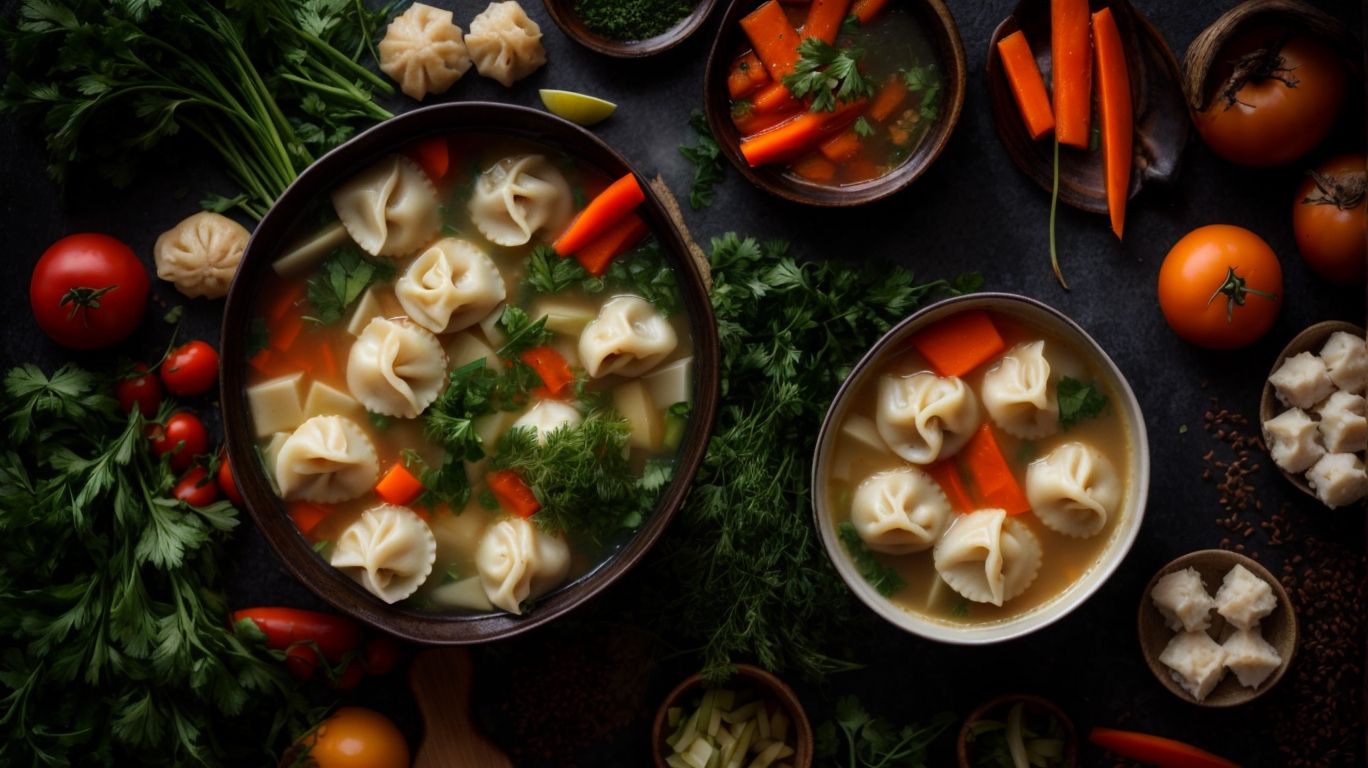
Credits: Poormet.Com – Brandon Allen
Achieving perfect dumplings requires attention to detail, such as keeping the dough cold and using a light hand, while ensuring precise measurements with a kitchen scale.
Regarding handling the dough, remember that overworking it can lead to tough dumplings. Let the dough rest covered for at least 30 minutes to relax the gluten. Use a rolling pin to gently roll it out to an even thickness, ensuring that it is not too thin or too thick.
While filling the dumplings, be creative with the ingredients, but ensure the right balance for flavor depth. Combining ground meat, finely chopped vegetables, and seasonings creates a harmonious filling. Remember to seal the dumplings tightly, eliminating any air pockets to prevent them from bursting during cooking.
Keep the Dough Cold
Maintaining cold dough consistency is essential for achieving the desired texture in dumplings, ensuring that the dough is properly chilled before cooking for optimal results.
When making dumplings, the cold dough plays a crucial role in creating the perfect balance of tenderness and chewiness in the final product. By keeping the dough cold, you slow down gluten development, which helps in achieving a soft and delicate texture. Handling the dough gently is equally important to maintain its cold temperature, so it’s advisable to work quickly and avoid overkneading. Refrigeration not only maintains the dough’s consistency but also makes it easier to shape the dumplings, ensuring they hold their form during cooking.
Use a Light Hand
Handling dumpling dough with a gentle touch is crucial to avoid overworking the flour and maintain the delicate structure needed for perfectly creased buns.
One essential tip for achieving this is to use your fingertips rather than the palms of your hands when kneading the dough. The gentle pressure applied through your fingertips allows for better control and prevents excessive force on the dough. Remember to lightly flour your work surface to prevent sticking without incorporating too much extra flour into the dough, which can lead to tough dumplings. Taking breaks between folding and shaping steps can also help relax the gluten in the dough, resulting in a more elastic and pliable texture.
Cook in a Covered Pot
Cooking dumplings in a covered pot traps steam and heat, ensuring that the dumplings are steamed to perfection, resulting in tender and flavorful outcomes.
When the pot is covered, the steam that rises from the simmering water gets trapped, circulating around the dumplings and cooking them evenly. This method of steaming helps preserve the delicate texture of the dumplings, keeping them moist and preventing them from drying out. The moisture levels are maintained within the pot, creating a steamy environment that imparts softness to the dumplings. The covered pot seals in the flavors and aromas, enhancing the taste and preserving the freshness of the dumplings until they are ready to be served.
Do Not Overcrowd the Pot
Avoid overcrowding the pot when cooking dumplings, as it restricts water circulation and may lead to uneven cooking, ensuring that each dumpling has enough space to expand and cook evenly.
Proper pot spacing is crucial for achieving perfectly cooked, delicious dumplings. When you overcrowd the pot, the dumplings are too close together, impeding the movement of water around them. This can result in some dumplings taking longer to cook than others, leading to inconsistencies in texture and taste.
By giving each dumpling enough room to expand, you allow them to cook uniformly. This also ensures that the dumplings do not stick together, and each one has the opportunity to absorb the flavors of the broth or sauce it is being cooked in.
How to Serve Dumplings for Soup?
Serving dumplings for soup involves ladling the warm broth into bowls and carefully placing the cooked dumplings, garnishing with fresh herbs and a kitchen towel for presentation.
To create an aesthetically pleasing presentation, consider arranging the dumplings neatly in the bowl, ensuring they are visible and easily accessible. Texture plays a crucial role in the overall dining experience, so strive for a delicate balance between the soft dumplings and flavorful broth. When ladling the broth, pour it gently over the dumplings to maintain their integrity and prevent them from breaking apart.
- You can enhance the visual appeal by sprinkling some sesame seeds or chopped scallions on top of the dish, adding a pop of color and extra flavor.
- Some traditional serving methods involve placing a small kitchen towel under the bowl, both for practicality in case of spills and for a touch of elegance.
Variations of Dumplings for Soup
Explore creative variations of dumplings for soup, including vegetarian options with flavorful fillings and spicy renditions that add a kick of heat to the classic comfort dish.
For those looking to cater to dietary restrictions, consider experimenting with gluten-free wrappers or incorporating plant-based proteins like tofu or mushrooms for a vegetarian-friendly twist. To elevate the spice factor, infuse the filling with chili paste, Szechuan peppercorns, or even a dash of Sriracha for an added punch of flavor. These adaptations not only introduce a new level of excitement and creativity to traditional soup dumplings but also cater to a wider range of palates with diverse tastes and preferences.
Vegetarian Dumplings
Vegetarian Dumplings for soup offer a plant-based twist on traditional recipes, with precise ingredient measurements ensuring a harmonious blend of flavors and textures.
When crafting vegetarian dumplings for soup, selecting high-quality ingredients is paramount. Opt for a combination of fresh vegetables like finely chopped mushrooms, carrots, and cabbage to provide depth and variety in each bite. Seasoning plays a crucial role in elevating the overall taste; consider a mix of soy sauce, garlic, ginger, and a hint of sesame oil for that umami-rich profile.
Accurate measurements of ingredients such as tofu, green onions, and cilantro are essential to maintain the perfect balance while ensuring the dumplings hold their shape during cooking. Consistency in size and thickness of the dumpling wrapper is also crucial for uniform cooking and presentation.
Gluten-free Dumplings
Gluten-free Dumplings cater to dietary preferences, offering a unique texture and flavor profile that complements soup dishes, with precise ingredient measurements ensuring gluten-free alternatives remain delicious.
When crafting gluten-free dumplings for soups, it’s essential to consider texture variations that can arise due to different gluten-free flours like rice flour, tapioca flour, or almond flour. Each flour brings its own unique consistency, affecting the chewiness and softness of the dumplings.
To ensure your gluten-free soup dumplings hold together and provide that satisfying bite, utilizing xanthan gum or psyllium husk powder can mimic the binding properties of gluten. These ingredients help maintain the structure and prevent the dumplings from becoming too crumbly or falling apart while cooking in the soup.
Spicy Dumplings
Spicy Dumplings for soup add a zesty kick to the dining experience, with ingredients like Chinkiang vinegar and steamed dim sum inspiration infusing bold flavors into each spoonful.
When creating these vibrant and zesty spicy soup dumplings, seasoning choices play a crucial role. Traditional options like ginger, garlic, and scallions bring depth and aroma, while spicier elements such as Sichuan peppercorns and chili oil elevate the heat level to match your preference. These variations draw from a rich culinary heritage, blending the warmth of Chinese spices with the tang of vinegar for a truly dynamic flavor profile. Whether you opt for a milder kick or a fiery explosion of taste, experimenting with these seasonings can personalize your spicy soup dumplings to suit your taste buds.
Conclusion
Dumplings for soup offer a delightful culinary experience, bringing together the warmth of broth and the comfort of well-crafted dough pockets in a harmonious blend of flavors.
These versatile dumplings, typically found in various culinary traditions around the world, serve as a symbol of warmth, love, and care. Whether filled with savory meats, vegetables, or even sweet surprises, soup dumplings cater to diverse preferences, reflecting the essence of cultural culinary heritage.
When enjoying a bowl of soup with these tender dumplings, one can’t help but appreciate the unique satisfaction that comes from biting into steaming, flavorful broth encapsulated within a soft and chewy wrapper. The combination of textures and tastes makes every spoonful a joyful experience, perfect for comforting meals or special occasions.
Frequently Asked Questions
How to Cook Dumplings for Soup?
What ingredients do I need to cook dumplings for soup?
You will need flour, salt, baking powder, butter, milk, and your choice of filling (such as ground meat, veggies, or cheese).
What is the best way to fold dumplings for soup?
The most common way is to fold the dough in half and seal the edges together. You can also fold the edges together to create a round shape, or use a dumpling press for more uniform results.
Can I make dumplings for soup ahead of time?
Yes, you can prepare the dumplings up to a day in advance and store them in the fridge. Just make sure to cover them with a damp towel to prevent them from drying out.
How to Cook Dumplings for Soup?
How do I prevent my dumplings from falling apart in the soup?
Make sure not to overfill the dumplings and seal the edges tightly. Also, avoid stirring the dumplings vigorously while they are cooking.
Can I use pre-made dumpling wrappers for soup?
Yes, you can use store-bought dumpling wrappers if you don’t want to make the dough from scratch. Just make sure they are thin and pliable enough to be folded without breaking.
How do I know when the dumplings are cooked?
The dumplings will float to the surface when they are cooked. You can also cut one open to check if the filling is cooked through.

